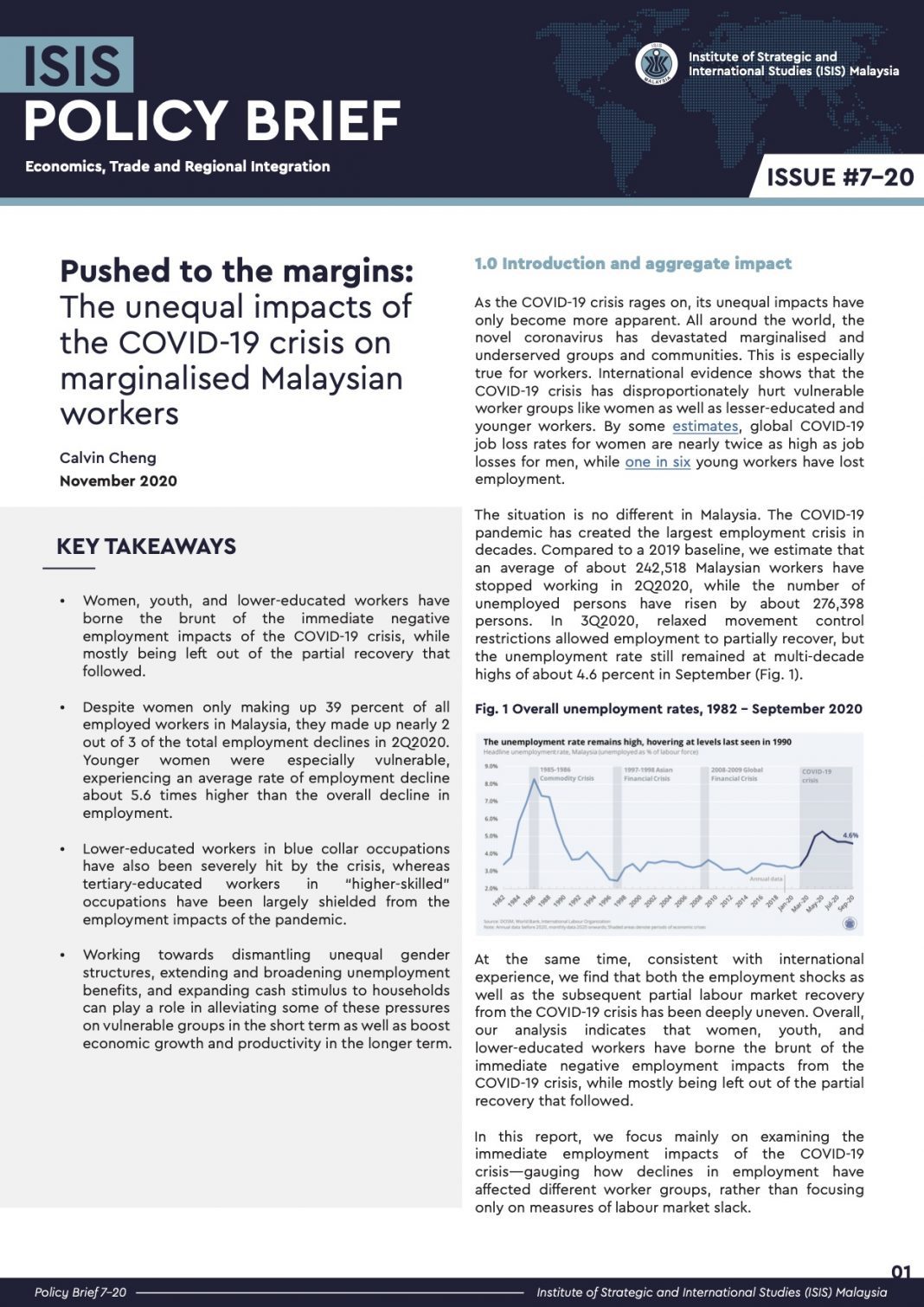Key takeaways
- Women, youth, and lower-educated workers have borne the brunt of the immediate negative employment impacts of the COVID-19 crisis, while mostly being left out of the partial recovery that followed.
- Despite women only making up 39 percent of all employed workers in Malaysia, they made up nearly 2 out of 3 of the total employment declines in 2Q2020. Younger women were especially vulnerable, experiencing an average rate of employment decline about 5.6 times higher than the overall decline in employment.
- Lower-educated workers in blue collar occupations have also been severely hit by the crisis, whereas tertiary-educated workers in “higher-skilled” occupations have been largely shielded from the employment impacts of the pandemic.
- Working towards dismantling unequal gender structures, extending and broadening unemployment benefits, and expanding cash stimulus to households can play a role in alleviating some of these pressures on vulnerable groups in the short term as well as boost economic growth and productivity in the longer term.
1.0 Introduction and aggregate impacts
As the COVID-19 crisis rages on, its unequal impacts have only become more apparent. All around the world, the novel coronavirus has devastated marginalised and underserved groups and communities. This is especially true for workers. International evidence shows that the COVID-19 crisis has disproportionately hurt vulnerable worker groups like women as well as lesser-educated and younger workers. By some estimates, global COVID-19 job loss rates for women are nearly twice as high as job losses for men, while one in six young workers have lost employment.
The situation is no different in Malaysia. The COVID-19 pandemic has created the largest employment crisis in decades. Compared to a 2019 baseline, we estimate that an average of about 242,518 Malaysian workers have stopped working in 2Q2020, while the number of unemployed persons have risen by about 276,398 persons. In 3Q2020, relaxed movement control restrictions allowed employment to partially recover, but the unemployment rate still remained at multi-decade highs of about 4.6 percent in September (Fig. 1).
Fig. 1 Overall unemployment rates, 1982 – September 2020

At the same time, consistent with international experience, we find that both the employment shocks as well as the subsequent partial labour market recovery from the COVID-19 crisis has been deeply uneven. Overall, our analysis indicates that women, youth, and lower-educated workers have borne the brunt of the immediate negative employment impacts from the COVID-19 crisis, while mostly being left out of the partial recovery that followed.
In this report, we focus mainly on examining the immediate employment impacts of the COVID-19 crisis—gauging how declines in employment have affected different worker groups, rather than focusing only on measures of labour market slack.
2.0 Women and youth have been the hardest hit
Women, particularly younger women, have experienced far greater declines in employment compared to older men. We estimate that compared to a 2019 pre-crisis average, the number of employed women fell by about 5 times more than the fall in employed men, recording a -2.5 percent decline in 2Q2020 (vs 2019), compared to just -0.5 percent for men. Put differently, despite women only making up 39 percent of all employed workers in Malaysia, women made up nearly 2 out of 3 of the total employment declines in 2Q2020 (Fig. 2). In 3Q2020, as movement restrictions were gradually lifted and labour market conditions improved slightly, the number of employed women still continued to decrease (albeit at a slower pace), even as men’s employment had already begun to recover (Fig. 2).
Fig. 2 Employment impacts by gender, 2Q-3Q 2020
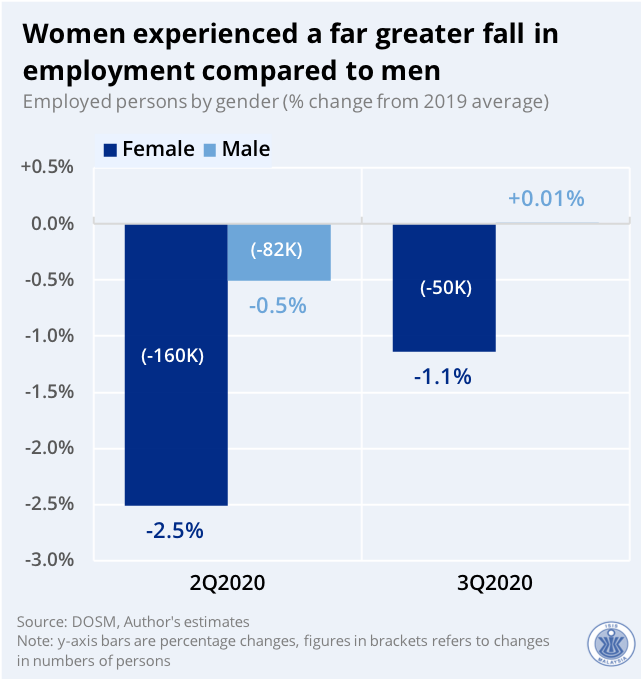
Fig. 3 Employment impacts by gender and age
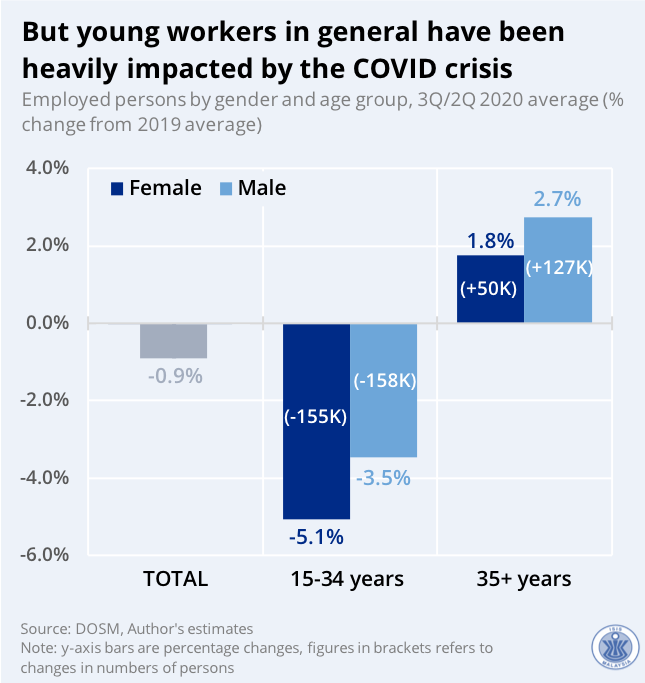
Beyond the gender aggregates, there is also a strong youth dimension to these employment declines. Younger workers in general were far more likely to have experienced adverse employment effects, with younger women especially susceptible. Over the past two quarters, compared to 2019, our estimates suggest that younger workers aged 13-34 years experienced an average fall in employment more than 4.5 times higher than the overall decline in employment (0.9 percent—see Fig. 3); while younger women in particular experienced an average decline in employment which was 5.6 times higher (-5.1 percent decline—see Fig. 3). Meanwhile, older workers have fared better. In particular, older men (35+ years) saw sizable employment gains in the post-crisis period (+2.7 percent) compared to a 2019 average.
But the impacts of the COVID-19 crisis on women go beyond just lower employment. Recent data indicates that more and more women have exited the labour force entirely. Over the past two quarters, Malaysia’s female labour force participation rate has declined drastically, reversing the steady progress made over the past two years in women’s workforce participation (Fig. 4). However, looking deeper at labour force numbers by age and gender highlights a significant degree of heterogeneity. Data suggests that younger women (and younger men to a lesser degree) were overwhelmingly more likely to have exited the labour force as opposed to older women and older men—experiencing a 3.0 percent decline in labour force numbers (Fig. 5).
Fig. 4 Female labour force participation
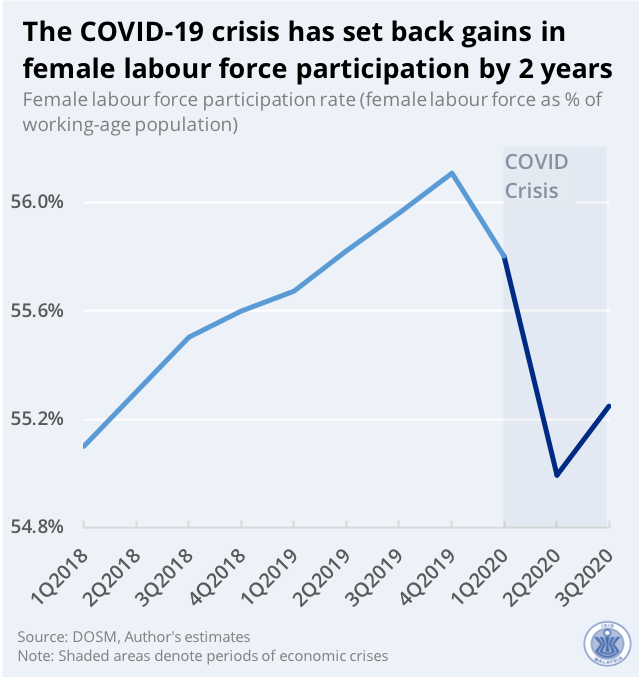
Fig. 5 Labour force numbers by gender and age
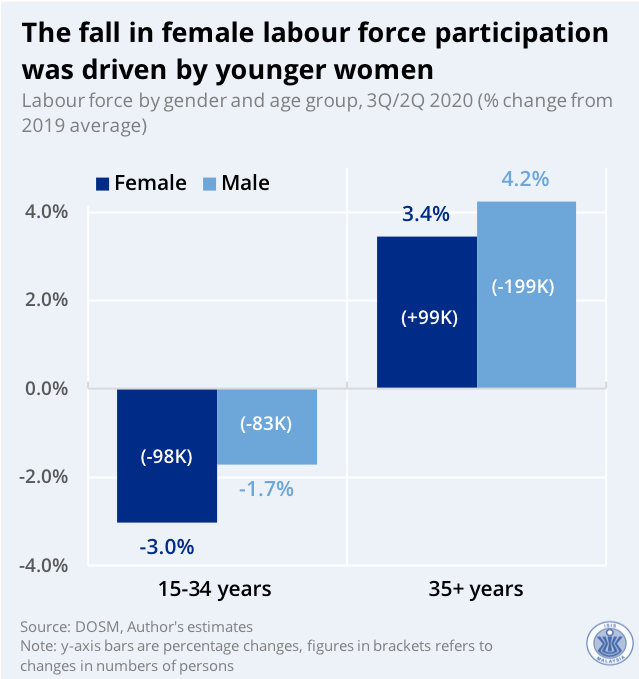
3.0 Structural gender inequities are a driving factor
These heavy employment losses suggest that women’s vulnerability to the labour market impacts of the COVID-19 crisis are due to a combination of several factors. Firstly, there is some evidence for industry-mix effects: (young) women workers are concentrated in some of the demand-sensitive industries hardest hit by the COVID-19 crisis. In Malaysia, these are industries like food services and accommodation, along with textiles and apparel (Fig. 6).
Yet, this only explains a small proportion of the disproportionate impact on women’s employment. The larger factor here is the pre-existing structural inequalities faced by women (particularly younger women). International evidence since the start of the COVID-19 crisis suggests that pre-existing socio-economic inequalities such as the burden of unpaid care work on women has been exacerbated by the increasing need for child/family care as health risks mount and as schools and care centres close.
This increase in unpaid care responsibilities, compounded by long-standing inequities in the labour market (like the gender pay gap and systemic discrimination in the workplace) have played an important role in contributing to both women’s disproportionate share of employment declines as well as higher workforce exits. Indeed, the exit of young women from Malaysia’s labour force coincided with an increase in persons outside the labour force citing “housework/family” preventing them from seeking paid work in recent workforce surveys (Fig. 7).
Fig. 6 Women’s labour share and job impacts by industry
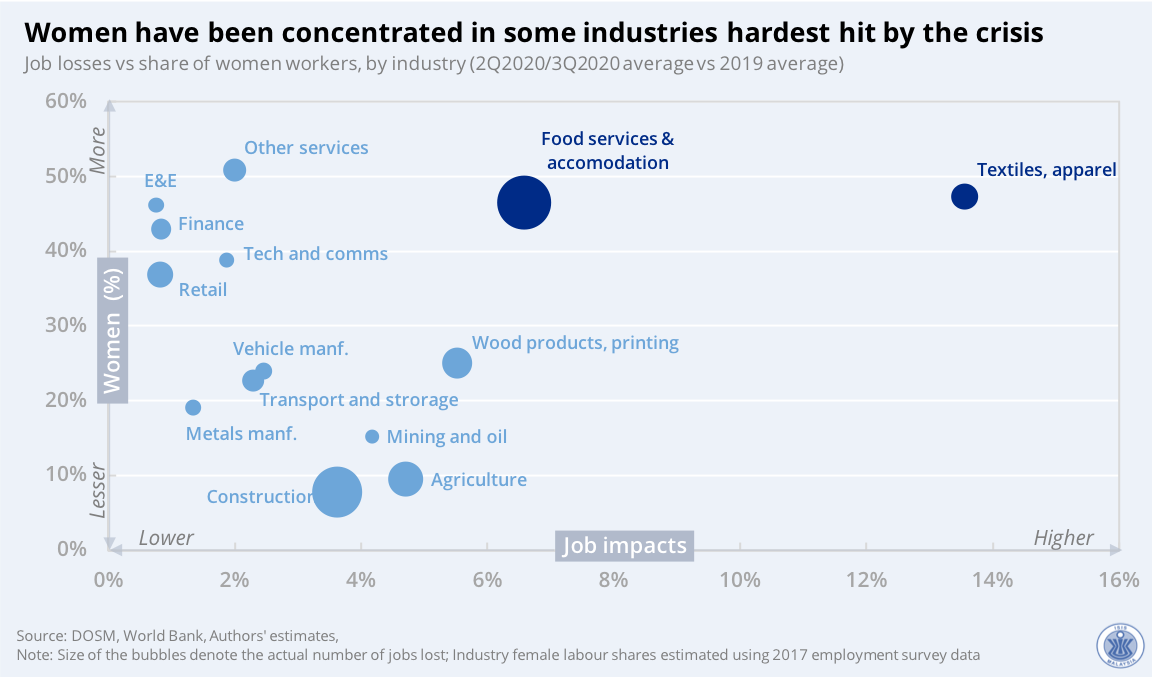
Fig. 7 Reasons for labour force non-participation*
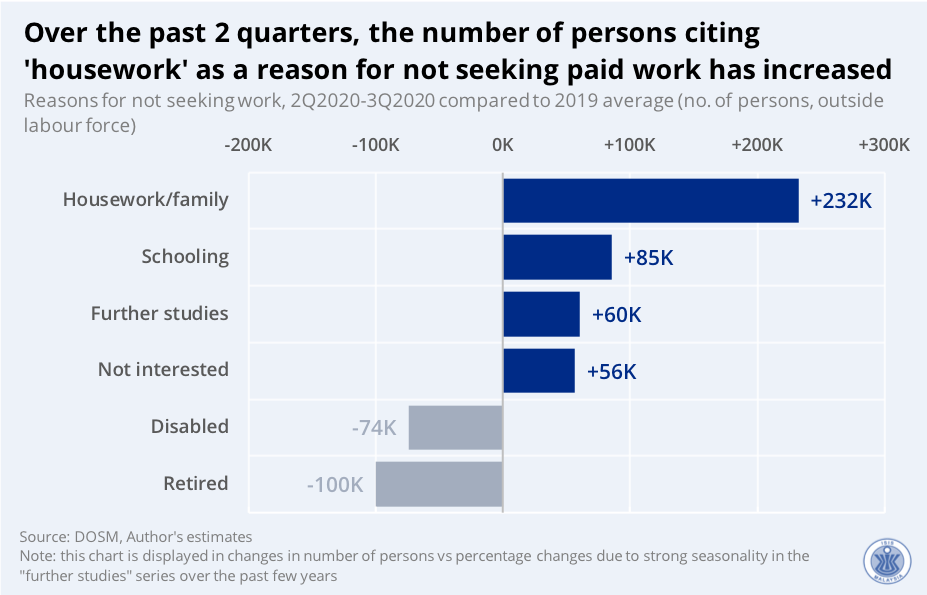
4.0 Lesser-educated workers in elementary occupations have also seen far larger employment impacts
Similarly, our analysis suggests that lower-educated workers in blue collar occupations have been more severely hit by the crisis, whilst tertiary-educated workers in “higher-skilled” occupations were largely shielded from employment declines.
Data disaggregated by educational attainment shows that that employment impacts have varied greatly by educational attainment (Fig. 8). Tertiary-educated workers, on balance, have still managed positive employment growth even in the crisis period. In contrast, lesser-educated workers have faced tremendous employment declines. In particular, workers with primary education and below recorded a 14.8 percent decline in employment compared to 2019—translating to an estimated 339,492 workers with primary education who have stopped work since the crisis began.
By occupation type, the data indicates a similar trend. Employment in lower-tech and blue collar occupations requiring more manual labour like ‘machine operators’, ‘elementary occupations’, and ‘craft and trade workers’ have been decimated by the crisis, with our estimates showing that about 130,025 machine operators and 99,425 workers in ‘elementary occupations’ have stopped work in the crisis period compared to a 2019 average (FIg. 9). Meanwhile, mirroring the employment impacts for tertiary workers (Fig. 8), white-collar occupations like ‘managers’ and ‘technicians’ have managed to see positive employment gains versus a 2019 average (Fig. 9). Based on status in employment, we also observe large employment declines in workers classified as ‘employer’—likely smallholder/micro-enterprise owners—as well as ‘self-employed’ workers (Fig. 10).
This stark educational and occupational divide in vulnerability is consistent with international experience with the COVID-19 crisis , highlighting issues such as the difficulty and availability of remote work for blue-collar occupations which mostly requires hands-on on-site work, compared to white-collar occupations and managerial positions. Similarly, it is well-documented that self-employed or casual/informal workers along with small/micro-enterprises are particularly susceptible to the demand shocks from the pandemic—due in large part to a lack of financial buffers and inadequate protection from social safety nets. This large divergence in employment impacts between higher-educated, “higher-skilled” professionals and lesser-educated workers will widen existing class and income disparities in the labour market. In reality, there may be substantial overlap between these vulnerable groups, with workers at the intersection of multiple vulnerabilities being particularly exposed to shocks. For instance, the majority of workers in the informal sector are women—and many of them are young and/or lesser-educated.
Fig. 8 Employment impacts by education
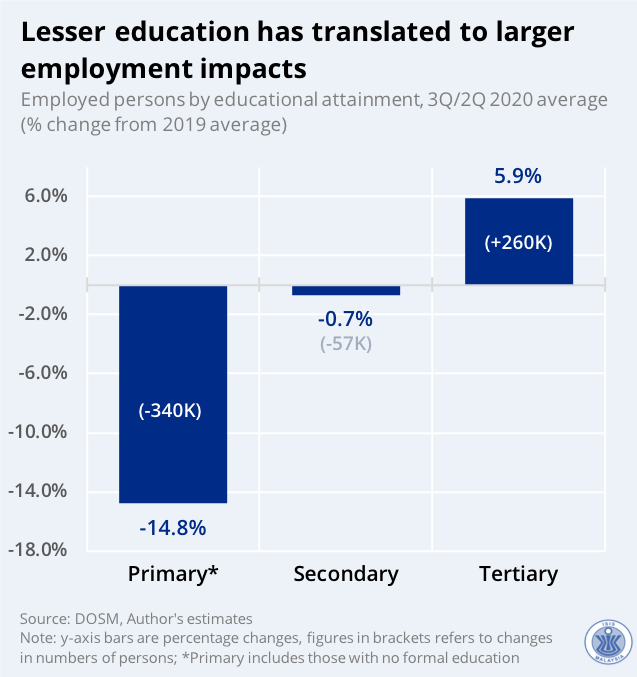
Fig. 9 Employment impacts by occupation (MASCO 2013)
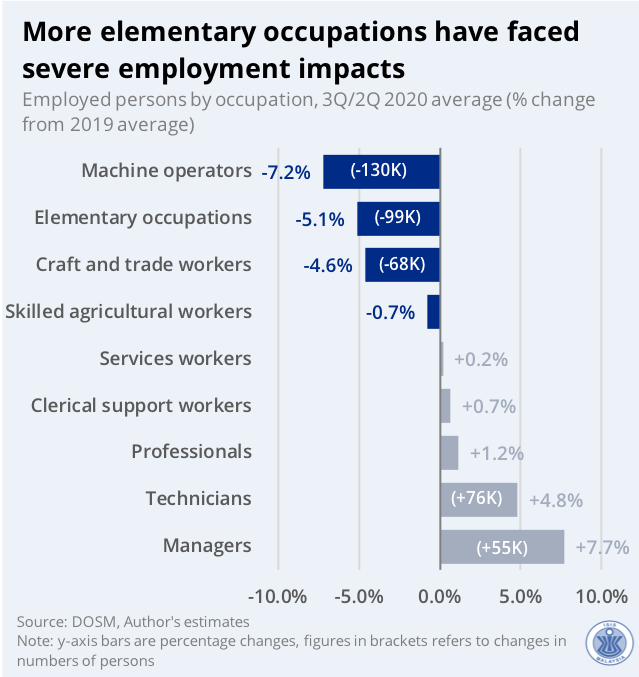
Fig. 10 Employment impacts by status in employment
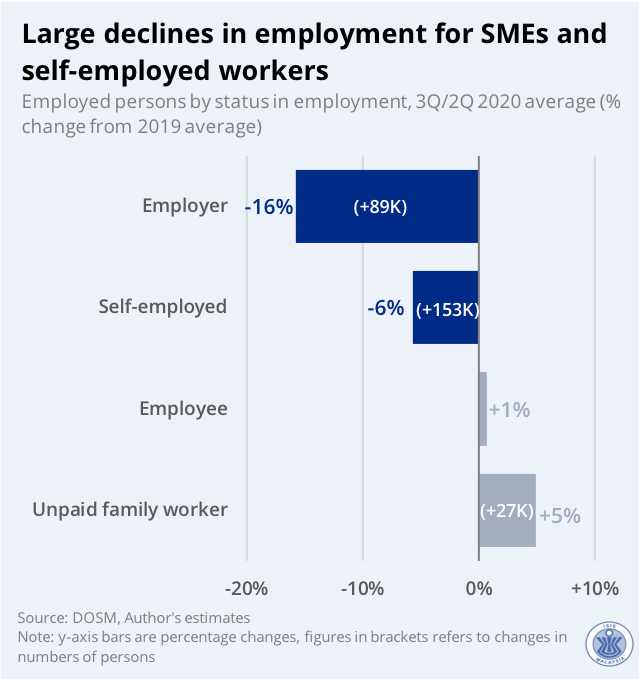
Fig. 11 Duration of unemployment
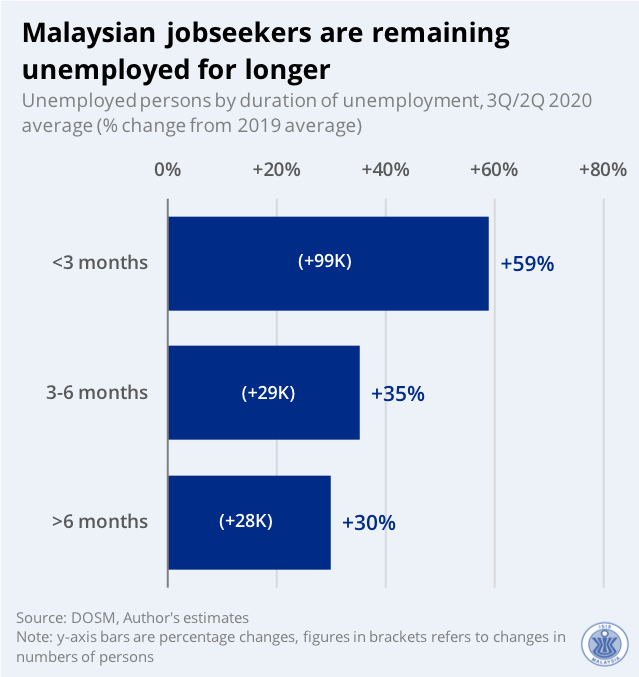
5.0 Policy action to safeguard Malaysian workers and households
As we have previously argued, decisive policy action can play a role in both alleviating some of these pressures in the immediate-term as well as increasing economic growth and productivity for the longer-term. We highlight four potential areas for policy action.
1. Expanding and extending unemployment benefits. Increasing the Employment Insurance System’ (EIS) Job Search Allowance (JSA) benefits and temporarily extending the current 6-month maximum limit for receipt of these unemployment benefits to 12-months will benefit more than half a million unemployed Malaysians. The COVID-19 crisis has dramatically depressed labour market conditions—and Malaysians are remaining unemployed for longeras a result. Already, the number of people who have been unemployed longer than 6 months in 2Q-3Q2020 has increased by 30 percent compared to 2019 (Fig. 11). Unemployment insurance needs to take this into account, and allow unemployed job seekers more time and financial headroom to seek employment before their current EIS JSA benefits run out. Expanding unemployment insurance will also disproportionately help women and youth jobseekers who have faced the greatest employment impacts from the crisis.
Additionally, broadening the scope of the EIS unemployment benefits to fully cover self-employed/independent workers as well as relaxing contributory conditions (CQC) will be a first step in closing large gaps in vulnerability for self-employed workers that were hit hard by the pandemic. These temporary expansions and extensions to the EIS should also be directly financed by the federal government through an act of parliament, rather than depleting the current pool of EIS payroll contributions.
2. Improve existing cash transfer programs and include cash support for childcare. The current 2020-2021 Bantuan Prihatin Nasional (BPN) supplementary emergency cash transfer program has already benefited millions of Malaysian households, and the new 2021 Bantuan Prihatin Rakyat (BPR), successor to the Bantuan Sara Hidup (BSH) cash transfers, represents a slight improvement in terms of benefit size. Yet, these programs are based largely on infrastructure and mechanisms inherited from the 2019-2020 Bantuan Sara Hidup (BSH) program. As such, mending pre-existing weaknesses in Malaysia’s cash transfer program infrastructure could have outsize impacts for the longer-term. These fixes include further increasing transfer sizes as well as allowing income targeting eligibility to vary by household income. Similarly, increasing efforts towards the reduction of targeting exclusion errors and program undercoverage—as well as making it altogether easier to apply and receive cash support—would decrease the number of people that fall through the cracks. Furthermore, building on earlier Penjana childcare eVouchers and expanding previous childcare subsidies for low-income families, and providing additional supplementary cash support for mothers with children would help to alleviate the rising burden of childcare amid the pandemic and help families return to work more easily.
3. Work towards confronting gender inequality. Inclusive fiscal policies that promote gender equality can contribute to dismantling structural issues that disadvantage women in the long-term whilst alleviating the negative immediate-term impacts. This would entail distributing the burden of care work more equitably, in part through subsiding childcare through cash transfers (see above) and/or through expanding public investment in accessible state-funded childcare facilities nationwide. Additionally, international evidence suggests that implementing federally-funded universal paid family leave policies that encourage greater sharing of paternity leave would distribute the responsibility of childcare more equitably, encourage quicker return-to-work for women, and shift cultural norms regarding gender roles in society. Concurrently, granting legal protection to women against labour market discrimination—including unequalhiring practices, the gender pay gap and issues related to sexual harassment —along with strengthening collective bargaining mechanisms and increasing union coverage amongst women workers can be a good first step to erode systemic discriminations in the workplace and make it easier for women to work.
4. Spending more on stimulating economic growth and supporting microenterprises. Expanding government spending to boost aggregate demand and tighten labour markets tends to benefit marginalised worker groups like youth, women, and lesser-educated workers whose employment is more cyclically-sensitive. To be sure, multiple stimulus efforts are already underway. However, there remains room for continued fiscal expansion, particularly if macroeconomic conditions and labour market indicators in the coming months show continued employment losses for vulnerable worker groups. Economic crises present good opportunities to invest in future productivity as borrowing costs are generally lower—MGS 10 year yields are near multi-decade lows as at time of writing—and fiscal expenditure multipliers are typically larger.
Here, we highlight three additional avenues for fiscal expansion that may provide the greatest bang-for-the-buck in terms of both its growth and distributional impacts.
Increase infrastructure spending. Adding on to the RM4 billion small-scale projects in underdeveloped regions presented in the Prihatin stimulus package, and the RM2.7 billion allocated for rural infrastructure in 2021, can raise long-term productivity and economic growth, especially if financed by higher government deficits.
Expand and extend the Special Prihatin micro-enterprise grant program. i.e. Geran Khas Prihatin (GKP). SMEs—and Micro-enterprises in particular—have faced high closure rates since the beginning of the crisis. While the GKP has been a lifeline to some micro-enterprises, overall it was broadly limited in terms of individual grant size (RM3,000 one-off per enterprise), as well as in program coverage: surveys suggest that a majority of micro-enterprises still have not received any government assistance, even while GKP 2.0 registrations have already closed in October 2020. Increasing GKP’s grant size and coverage can help small businesses survive the crisis and reduce the numerous costs of business closures.
Increase direct cash stimulus to households. Research has shown that direct cash stimulus to households via cash transfers or immediate tax rebates get money out into the real economy much quicker than other conventional fiscal stimulus tools like corporate tax cuts—as well as having high growth impacts. Emergency cash support to households can also be made automatic—pre-set to trigger whenever macroeconomic indicators worsen below a specified threshold, helping to automatically safeguard the welfare of lower-income households amid periods of economic turmoil whilst supporting economic growth.
6.0 Conclusion
In Malaysia, our report suggests that vulnerable worker groups like women, youth, lesser-educated, and self-employed/independent contractors have experienced employment losses many times higher than the average worker. Moreover, the partial recovery that followed has tended to exclude workers from these vulnerable groups—instead mostly favouring workers who are male, older, higher-educated and more experienced.
As global COVID-19 infections continue to mount, it may be tempting to think that the virus affects the rich and the poor equally—knowing no race, gender or age. Yet, reality is quite the opposite. All around the world, recent data has shown that the crisis overwhelmingly hurts marginalised communities already suffering deep-seated inequities even before the onset of the pandemic. Millions of lives and billions of livelihoods have been decimated by COVID-19, but assessing the impacts of this crisis by just looking at aggregates would be missing the point.
___________
Reference list
- Aaronson, Stephanie R., Mary C. Daly, William Wascher, and David W. Wilcox. 2019. “Okun Revisited: Who Benefits Most from a Strong Economy?”. Brookings Papers on Economic Activity Conference Draft, March 7-8. Brookings Institution. Available at: https://www.brookings.edu/wp-content/uploads/2019/03/Okun-Revisited-Who-Benefits-Most-From-a-Strong-Economy.pdf
- Blundell, Jack, Stephen Machin, and Maria Ventura. 2020. “Covid-19 and the self-employed: Six months into the crisis”. Center for Economic Performance, Paper No.012, November 2020. Available at: http://cep.lse.ac.uk/pubs/download/cepcovid-19-012.pdf
- Cheng, Calvin. 2020. “COVID-19 in Malaysia: Economic Impacts & Fiscal Responses”. Institute of Strategic and International Studies (ISIS) Malaysia, Policy brief 1-20. Available at: https://www.isis.org.my/2020/04/10/economics-of-a-global-pandemic-malaysian-impacts-and-responses/
- Cheng, Calvin. 2020. “We’re already in a global recession: here’s what we can do”. Institute of Strategic and International Studies (ISIS) Malaysia. Available at: https://www.isis.org.my/2020/05/18/were-already-in-a-global-recession-heres-what-we-can-do/
- Cheng, Calvin, Juita Mohamad, and Salina Salleh. Unpublished. “Preliminary Analysis of the Impacts of COVID-19 in Malaysia”. Institute of Strategic and International Studies (ISIS) Malaysia.
- Chung, Heejung. 2020. “Return of the 1950s housewife? How to stop coronavirus lockdown reinforcing sexist gender roles”. The Conversation, 20 March 2020. Available at: https://theconversation.com/return-of-the-1950s-housewife-how-to-stop-coronavirus-lockdown-reinforcing-sexist-gender-roles-134851
- Department of Statistics, Malaysia. 2020. Labour Force Survey, various years. Available at: https://www.dosm.gov.my/v1/index.php?r=column/ctimeseries&menu_id=bnk3bk0wTTkxOXVHaVg3SUFDMlBUUT09
- Davenport, Christian, Aaron Gregg, and Craig Timberg. 2020. “Working from home reveals another fault line in America’s racial and educational divide”. Washington Post, 23 March 2020. Available at: https://www.washingtonpost.com/business/2020/03/22/working-home-reveals-another-fault-line-americas-racial-educational-divide/
- Edelberg, Wendy and Louise Sheiner. 2020. “What could additional fiscal policy do for the economy in the next three years?”. Brookings Institution. Available at: https://www.brookings.edu/research/what-could-additional-fiscal-policy-do-for-the-economy-in-the-next-three-years/
- EMPLAB, ILO. 2020. “A gender-responsive employment recovery: Building back fairer”. ILO Policy Brief, July 2020. International Labour Organization. Available at: https://www.ilo.org/wcmsp5/groups/public/—ed_emp/documents/publication/wcms_751785.pdf
- Fabeil, Noor Fzlinda and Khairul Hanim Pazim, and Juliana Langgat. 2020. “The Impact of COVID-19 Pandemic Crisis on Micro-Enterprises: Entrepreneurs’ Perspective on Business Continuity and Recovery Strategy”. Journal of Economics and Business, Vol.3 No.2. Available at: https://ssrn.com/abstract=3612830
- Gould, Elise, and Melat Kassa. 2020. “Young workers hit hard by the COVID-19 economy”. Economic Policy Institute, 14 October 2020. Available at: https://files.epi.org/pdf/203139.pdf
- Hupkau, Claudia, and Barbara Petrongolo. 2020. “Work, care and gender during the Covid-19 crisis”. Center for Economic Performance, Paper No.002, May 2020. Available at: https://cep.lse.ac.uk/pubs/download/cepcovid-19-002.pdf
- IMF. 2018. “Pursuing Women’s Economic Empowerment”. International Monetary Fund Policy Paper May 2018. Available at: https://www.imf.org/en/Publications/Policy-Papers/Issues/2018/05/31/pp053118pursuing-womens-economic-empowerment
- International Labour Organization, Bangkok (Thailand), and Asian Development Bank, Manila (Philippines). 2020. “Tackling the COVID-19 youth employment crisis in Asia and the Pacific”. Available at: https://www.ilo.org/wcmsp5/groups/public/—asia/—ro-bangkok/documents/publication/wcms_753369.pdf
- Lim, Lin Lean. 2020. “The socioeconomic impacts of COVID-19 in Malaysia: Policy review and guidance for protecting the most vulnerable and supporting enterprises”. International Labour Organization. Available at: http://ilo.org/wcmsp5/groups/public/—asia/—ro-bangkok/documents/publication/wcms_751600.pdf
- Madgavkar, Anu, Olivia White, Mekala Krishnan, Deepa Mahajan, and Xavier Azcue. 2020. “COVID-19 and gender equality: Countering the regressive effects”. McKinsey Global Institute. Available at: https://www.mckinsey.com/featured-insights/future-of-work/covid-19-and-gender-equality-countering-the-regressive-effects
- Major, Lee Elliot, Andrew Eyles, and Stephen Machin. 2020. “Generation COVID: Emerging work and education inequalities”. Center for Economic Performance, Paper No.011, October 2020. Available at: http://cep.lse.ac.uk/pubs/download/cepcovid-19-011.pdf
- Park, Cyn-Young, and Ancilla Marie Inocencio. 2020. “COVID-19, Technology, and Polarizing Jobs” ADB Briefs No.147, August 2020. Asian Development Bank. Available at: https://www.adb.org/sites/default/files/publication/623036/covid-19-technology-polarizing-jobs.pdf
- Power, Kate. 2020. “The COVID-19 pandemic has increased the care burden of women and families”. Sustainability: Science, Practice and Policy, Volume 16:1. Available at: https://www.tandfonline.com/doi/full/10.1080/15487733.2020.1776561
- Sahm, Claudia. 2019. “Direct Stimulus Payments to Individuals”. The Hamilton Project and Brookings Institution. Available at: https://www.hamiltonproject.org/assets/files/Sahm_web_20190506.pdf
- Schmillen, Achim Daniel, Mei Ling Tan, Amanina Binti Abdur Rahman, Shahrul Natasha Binti Halid Lnu, and Nina Weimann Sandig. 2019. “Breaking Barriers: Toward Better Economic Opportunities for Women in Malaysia (English)”. The Malaysia Development Experience Series. World Bank Group. Available at: https://documents.worldbank.org/curated/en/734461569247873555/
- Welsh, Bridget, and Calvin Cheng. 2020. “On the Unemployed Frontline: Malaysia’s Youth and COVID-19”. Institute of Strategic and International Studies (ISIS) Malaysia. Available at: https://www.isis.org.my/2020/04/18/on-the-unemployed-frontline-malaysias-youth-and-covid-19/
- Xavier, Irene. 2020. “Equal pay for work of equal value is a misunderstood concept”. The Star. 22 September. Available at: https://www.thestar.com.my/opinion/letters/2020/09/22/equal-pay-for-work-of-equal-value-is-a-misunderstood-concept



